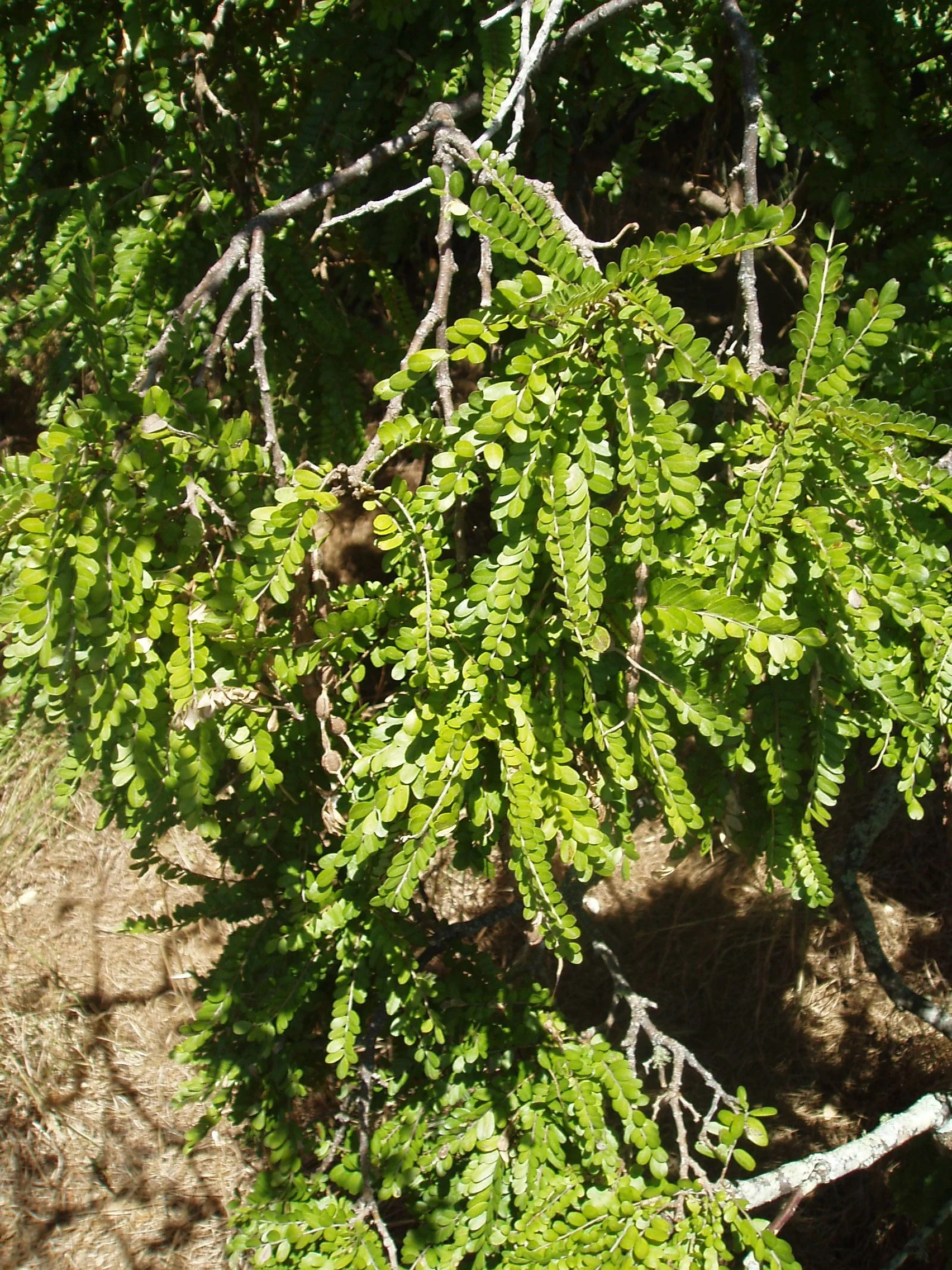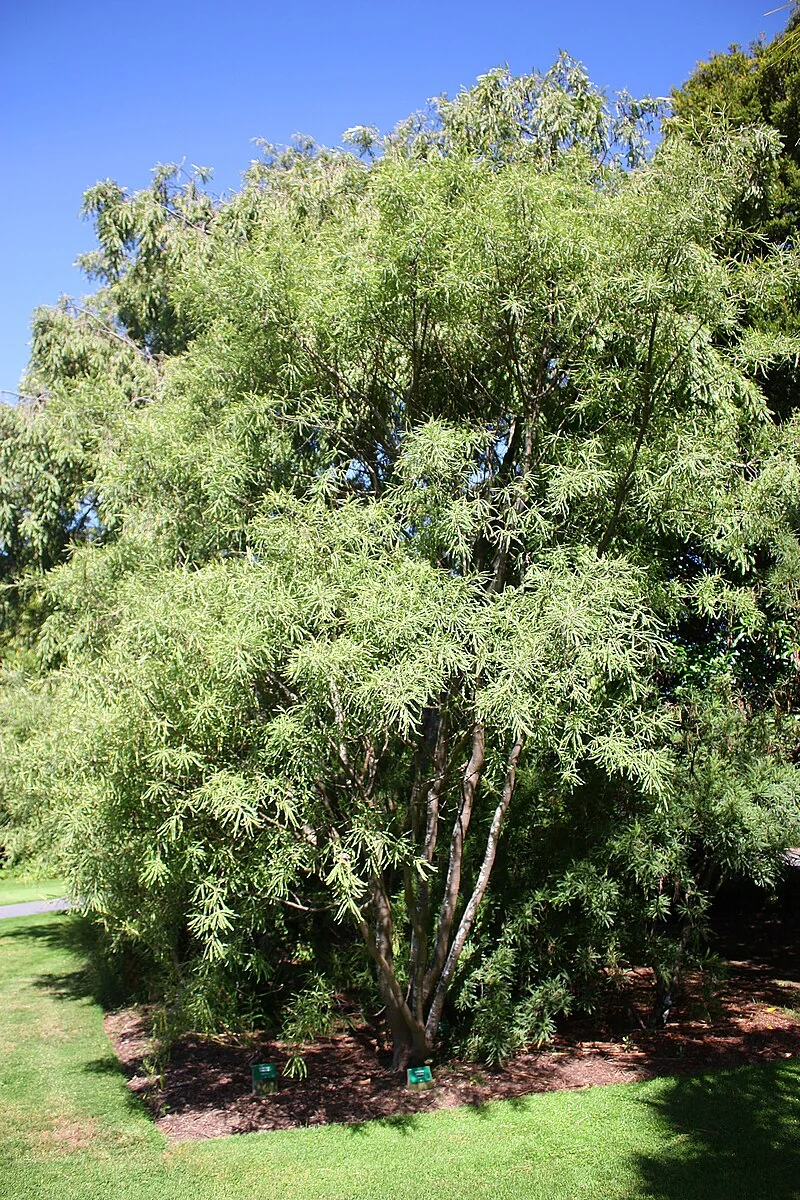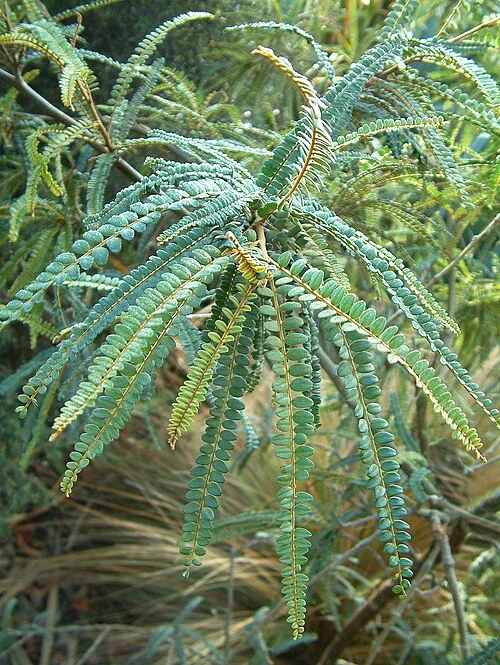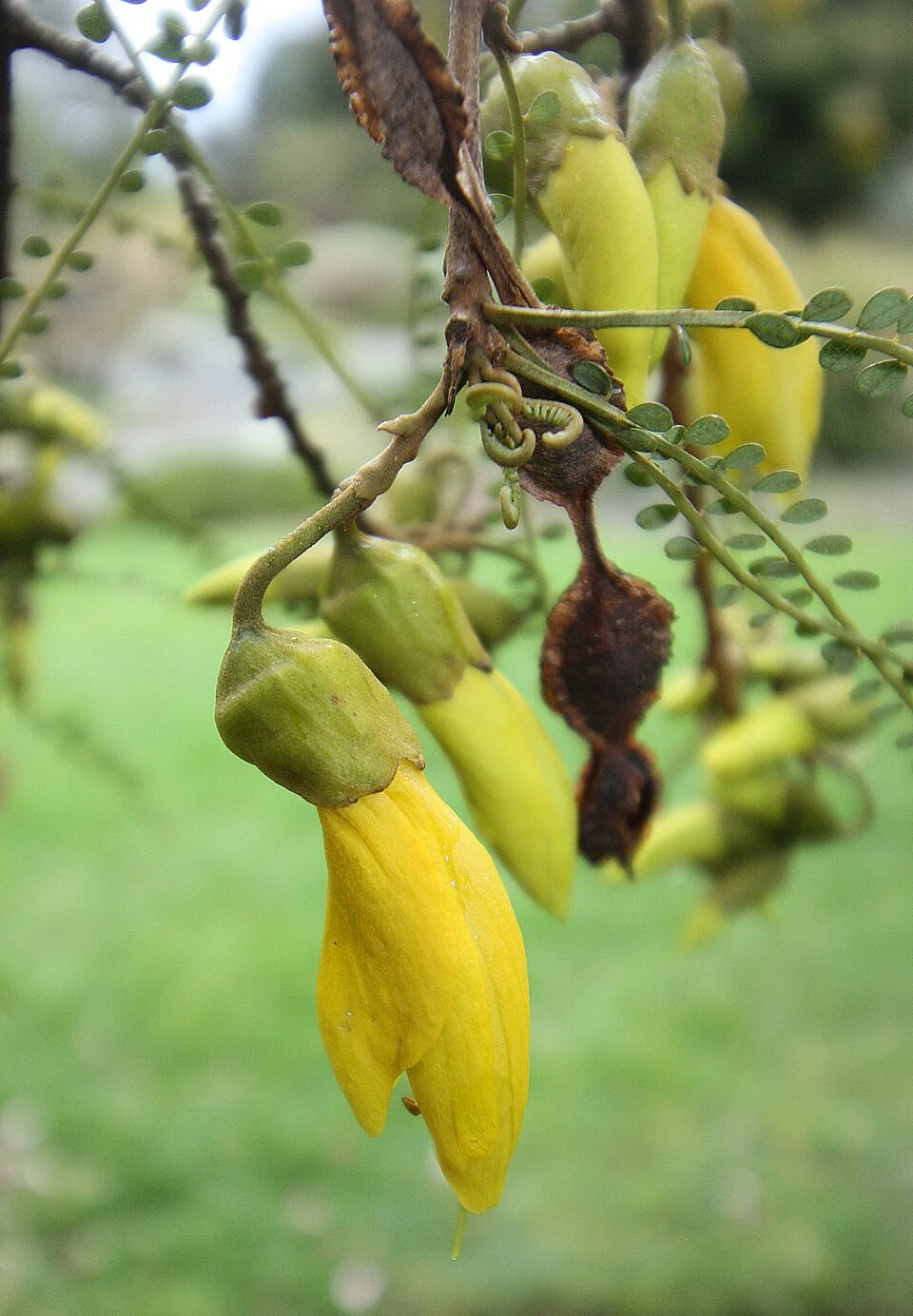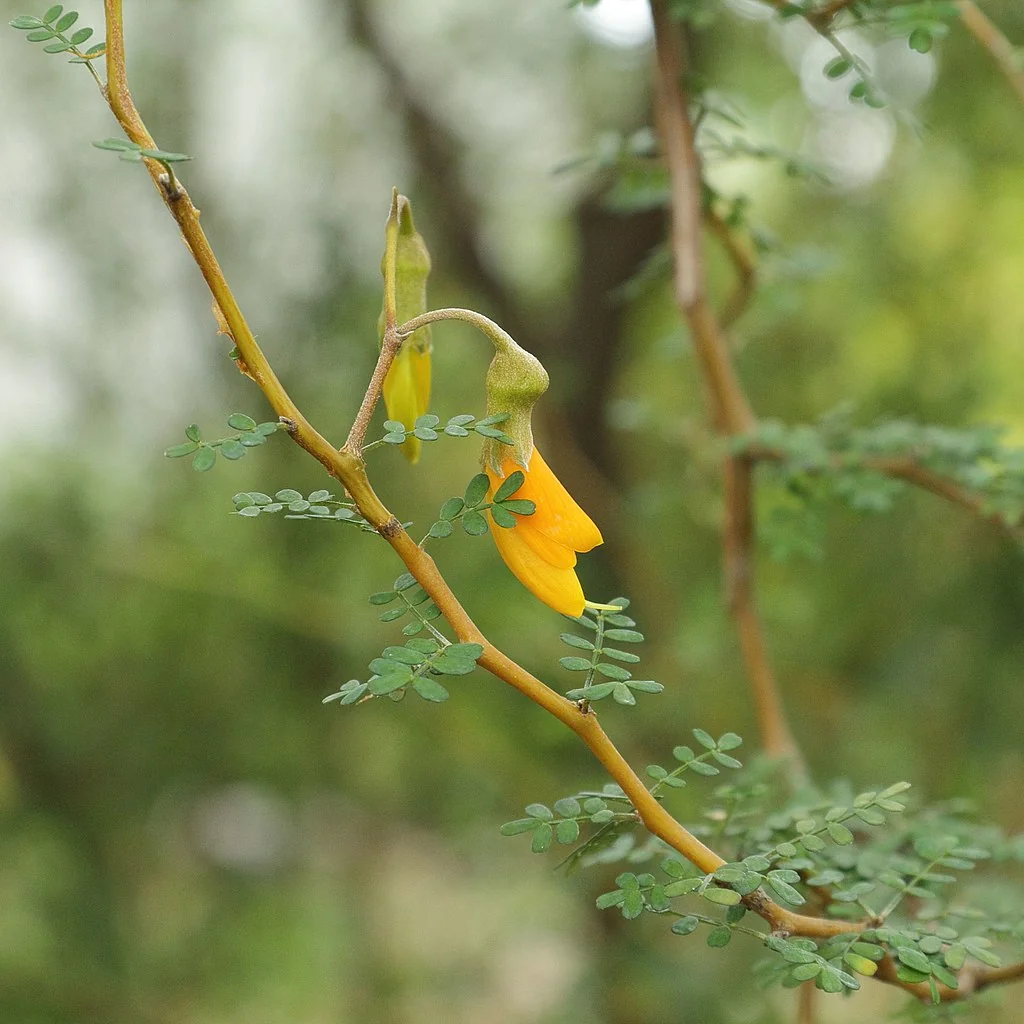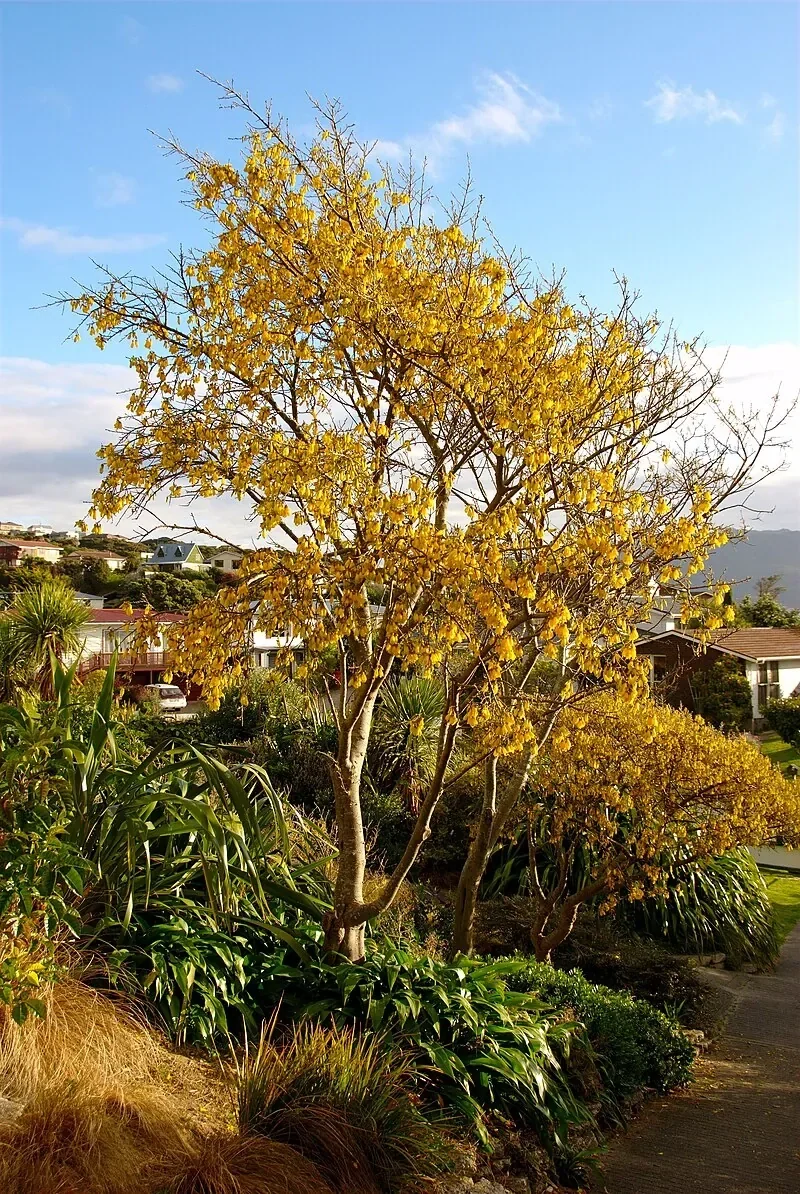
Kōwhai
Sophora microphylla
Introduction
Kōwhai (scientific name: Sophora microphylla ) is one of New Zealand's most beloved native trees, renowned for its spectacular golden-yellow flowers that herald the arrival of spring. This graceful tree, also known as weeping kōwhai, features delicate pinnate leaves and drooping branches that create an elegant weeping form. As New Zealand's unofficial national flower, kōwhai holds deep cultural significance and is treasured in gardens worldwide for its stunning autumn and spring display. Explore more in the native plants index .

Plant Description
Botanical Features
Kōwhai ( Sophora microphylla ), also known as weeping kōwhai or small-leaved kōwhai, is a flowering tree native to New Zealand. It is the most widespread of the eight kōwhai species found in the country. It can grow up to 8 meters tall and broad, though some sources indicate it can reach up to 25 meters. It is an evergreen shrub or small tree with weeping and spreading branches. The specific epithet "microphylla" means "small-leaved," referring to its fern-like leaves. Each leaf can be up to 10 cm long, with up to 40 pairs of small, shiny, oval leaflets, typically 3-6 mm long by 2-5 mm wide. It produces showy, pea-like, golden-yellow flowers in clusters, usually from August to October, or as early as May. These horn-shaped flowers are a favorite food source for native New Zealand birds like Tūī, Bellbird, and Kererū. Young Sophora microphylla trees exhibit a distinctive divaricating and bushy growth habit with many interlacing, zig-zagging branches. This tangled form gradually straightens and develops an upright trunk around four years of age. After flowering, it produces dry, ridged, and knobbly seed pods, 50-200 mm long, containing hard yellow seeds.
Quick Facts
Essential Information
| Scientific Name | Sophora Microphylla |
|---|---|
| Height | Up to 10 m |
| Spread | 3 - 5 m |
| Water Needs | Low to moderate; drought-tolerant |
| Light | Full sun |
| Frost Tolerance | High |
| Salt Tolerance | Moderate |
| Growth Rate | Slow to moderate |
| Lifespan | Long-lived tree |
Climate Best Suited to
Kōwhai is found throughout New Zealand, from coastal areas to inland forests. It is very hardy and adaptable, tolerating a wide range of conditions including frost, wind, and coastal spray. It is a versatile tree for almost any garden in the country.
Regional Suitability
| City | Climate Suitability |
|---|---|
| Whangārei | Ideal |
| Auckland | Ideal |
| Hamilton | Ideal |
| Tauranga | Ideal |
| Rotorua | Ideal |
| Gisborne | Ideal |
| New Plymouth | Ideal |
| Napier | Ideal |
| Whanganui | Ideal |
| Palmerston North | Ideal |
| Wellington | Ideal |
| Nelson | Ideal |
| Christchurch | Ideal |
| Dunedin | Ideal |
| Invercargill | Ideal |
Natural Habitat
Kōwhai ( Sophora microphylla ), also known as weeping kōwhai or small-leaved kōwhai, is native to New Zealand and is the most widespread of the eight kōwhai species found there. Its natural habitat is diverse and includes a wide range of environments across both the North and South Islands.
Key Habitats Include:
- Riparian Forests: It is frequently found in riparian forests, particularly in the North Island, thriving along riverbanks and stream sides.
- Coastal and Inland: It grows in coastal cliff faces and associated wetlands, as well as in inland grey scrub communities. Its adaptability allows it to inhabit river terraces, dunes, flood plains, lake margins, hill slopes, and rocky ground.
Preferred Conditions:
- Soil: While adaptable to various soil types, it prefers well-draining, free-draining soil rich in organic matter. Good drainage is essential to prevent root rot.
- Light: It flowers best in full sun positions, ideally receiving more than 6 hours of direct sunlight daily, though it can tolerate partial shade.
- Tolerance: It is very hardy and adaptable, tolerating a wide range of conditions including frost, wind, and coastal spray.
The widespread distribution and adaptability of Sophora microphylla underscore its ecological importance in contributing to the biodiversity and structural complexity of New Zealand's natural landscapes.
Plant Conservation
Sophora microphylla , commonly known as weeping kōwhai or small-leaved kōwhai, is a flowering tree native to New Zealand and is the most widespread of the eight kōwhai species endemic to the country. While generally classified as "Not Threatened" nationally, its conservation status can vary regionally, with some areas listing it as "At Risk - Declining" or "Threatened - Regionally Vulnerable." Key threats include hybridization and inappropriate planting, habitat loss due to forest clearance, and browsing by introduced mammals. Conservation efforts focus on habitat restoration and protection, seed collection and propagation, community engagement, and monitoring.
Growing Requirements
Soil Requirements
Small-leaved Kōwhai ( Sophora microphylla ) prefers well-draining, free-draining soil rich in organic matter. While adaptable to a wide range of soil types, including poor soils once established, it performs best in loamy soil with a slightly acidic to neutral pH (6-7). Good drainage is essential to prevent root rot, especially in heavy clay soils.
Light Requirements
Small-leaved Kōwhai flowers best in full sun positions, ideally receiving more than 6 hours of direct sunlight daily, though it can tolerate partial shade. Full sun exposure promotes the most abundant flowering display and healthy growth. Provide protection from strong winds, especially when young, as this can damage the delicate foliage and branches.
Water Requirements
Small-leaved Kōwhai requires regular watering during establishment in the first few years to develop strong roots. Once established, it becomes remarkably drought-tolerant and prefers drier conditions, benefiting from occasional deep watering during very dry periods. Avoid overwatering, which can lead to root problems, as it is sensitive to waterlogged roots.
Planting Guide
Sophora microphylla , commonly known as Kōwhai, is a flowering plant native to New Zealand, recognized for its bright yellow flowers that attract birds.
1. Site Selection
- Sunlight: Sophora microphylla thrives in bright, direct sunlight, ideally receiving at least 6 hours of direct light per day. It can also tolerate partial shade.
- Temperature: It prefers moderate temperatures, around 18°C (64°F), and should be protected from frost, especially when young. It is resilient to low temperatures, surviving down to at least -6.67°C (20°F).
- Shelter: Plant it in a sheltered location, possibly against a south-facing wall, to protect young trees from wind and frost damage.
2. Soil
- Type: This plant prefers well-draining loamy soil. A mix of garden soil with sand and organic matter works well. It can also grow in chalky or sandy soil.
- pH: It prefers a slightly acidic to neutral pH (around 6.5).
- Drainage: Good drainage is crucial to prevent root rot. If your soil is heavy clay, consider planting in a raised bed.
3. Planting
- General: Plant in moderately fertile, free-draining soil.
- Seedlings: Transplant seedlings into larger pots once they reach 15cm or more. Ensure they receive plenty of water regularly during summer months.
- Pots: If planting in a pot, choose one slightly larger than the current one with good drainage. Repot every 2-3 years or when the plant outgrows its container, ideally in spring before the growing season.
4. Watering
- Kōwhai prefers drier conditions and is drought-tolerant, needing water only when the soil is almost completely dry, approximately every two weeks.
- Water deeply during dry periods, especially in the first year of growth. Reduce watering gradually in autumn to prepare for winter dormancy.
5. Fertilization
- Use a balanced fertilizer with an NPK composition like 5-10-10 during the growing season. Fertilize every 4-6 weeks to support healthy growth and flowering.
- Apply slow-release, all-purpose formulas with equal NPK ratios in spring, reducing strength in autumn. Water thoroughly after fertilizing.
- For potted plants, use a liquid fertilizer every four weeks during the growing season.
6. Pruning
- Regular pruning is necessary to maintain shape and encourage flowering.
- The best time to prune is after the flowering period, typically in early to late winter or early spring, before new growth begins.
- Remove dead or damaged branches and thin dense areas for better airflow. Lighter, frequent trims can enhance blooming and minimize disease.
7. Propagation
- Sophora microphylla can be propagated through seeds or cuttings.
- Seeds: Seeds have a hard outer coating and require pre-treatment. Scarify them (pierce with a needle or nick the seed coat) and soak them in warm water for 24 hours until they swell. Sow on a firm bed of seed-raising mix and cover lightly. Germination can take a few weeks to several months.
- Cuttings: Take cuttings in late spring or early summer. For semi-hardwood cuttings, the optimal time is late summer or early autumn. Select healthy, non-flowering stems, cut a 10-15cm section below a leaf node, remove lower leaves, and plant in a well-draining potting mix. Rooting hormone is optional but recommended.
8. Toxicity
- All parts of the Sophora microphylla plant are poisonous, especially the seeds, due to toxic alkaloids like Cytisine. Ingestion can cause symptoms such as vomiting, diarrhea, and lethargy. Keep the plant out of reach of children and pets.
9. Other Important Notes
- Kōwhai is an important nitrogen-fixing plant, which helps improve soil fertility.
- Its flowers are a valuable source of nectar for bees and other pollinators, and it provides food and shelter for native birds.
- Kōwhai trees can take 6 to 10 years to reach maturity and produce significant blooms.
Ecological Role
Bird-Flower Mutualism
Common kōwhai ( Sophora microphylla ) is a keystone nectar source for tūī and bellbird at the end of winter when few other natives are in bloom. Flowers also support native pollinating insects on calm, sunny days.
River-Edge Specialist
Frequently found on river terraces and well-drained alluvium, it contributes to bank stability while allowing sunlight to reach ground flora. Its deep roots and leaf litter help build soils on scoured edges.
Host Interactions
The endemic kōwhai moth ( Uresiphita polygonalis maorialis ) utilises foliage; brief defoliation events are usually outgrown by healthy trees. As a nitrogen fixer, the species enriches soils for neighbouring natives.
Uses and Significance
A National Treasure
- Specimen Tree: Its beautiful form and stunning flowers make it an outstanding specimen tree for any garden.
- Wildlife Garden: The flowers provide an essential early spring food source for nectar-feeding birds like tūī, bellbirds, and silvereyes. The seeds are eaten by kererū.
- Cultural Importance: Kōwhai is New Zealand's unofficial national flower. It holds great cultural significance for Māori, with its flowering being a key indicator of the time for planting kūmara (sweet potato).
- Rongoā (Traditional Māori Medicine): The bark and leaves were used for various medicinal purposes, including as a poultice for wounds and to treat skin conditions. Note: All parts of the kōwhai are poisonous if ingested.
Landscaping Ideas
Wildlife and Riversides
Use common kōwhai along sunny river terraces and in wildlife-friendly gardens to provide nectar at winter's end. Underplant with hebes and grasses for a natural, low-care matrix.
Seasonal Care
Small-leaved Kōwhai ( Sophora microphylla ) is a hardy and adaptable tree, but understanding its seasonal needs will help ensure its vibrant flowering and overall health. Its unique flowering cycle in late winter/early spring makes it a standout native.
Spring
- Planting: Spring is an ideal time for planting new Kōwhai trees, allowing them to establish before the summer heat.
- New Growth: New foliage emerges after the winter flowering period.
- Feeding: Begin a monthly liquid feeding program with a balanced fertilizer from spring through autumn to encourage healthy root development and prepare for the next flowering cycle. Apply annual compost around the drip line.
- Watering: Monitor soil moisture and ensure consistent watering, especially for young plants.
Summer
- Watering: Young plants require regular watering to establish strong root systems. Established trees are drought-tolerant but benefit from occasional deep watering during very dry periods.
- Pest Monitoring: Monitor for Kōwhai moth caterpillars, which can defoliate trees but rarely cause permanent damage to healthy plants.
- Feeding: Continue monthly liquid feeding.
Autumn
- Planting: Autumn is another suitable planting time as temperatures moderate.
- Leaf Drop: Trees may begin to lose some leaves as they prepare for dormancy.
- Feeding: Complete the feeding program by the end of autumn.
- Seed Collection: Collect mature seeds if propagation is desired. Remember they have very hard coats and will need scarification.
Winter
- Flowering: Winter brings the spectacular flowering display of Small-leaved Kōwhai, typically from June to September. Trees are often semi-deciduous and may lose most leaves just before flowering, making the yellow blooms even more prominent.
- Watering: No feeding or regular watering is required for established plants during this period.
- Frost Protection: Protect young trees from heavy frost, which can damage soft foliage.
Pruning
Techniques and Timing
Small-leaved Kōwhai ( Sophora microphylla ) generally requires minimal pruning as it naturally develops an attractive form. Most maintenance involves removing dead, damaged, or crossing branches to maintain tree health and structure.
- Maintenance Pruning: Remove dead, damaged, or diseased wood as needed. This can be done at any time of year.
- Formative Pruning: Young trees may benefit from light formative pruning to establish a good structure and encourage a strong framework.
- Timing: Prune after the flowering period (typically late winter/early spring) to avoid cutting off flower buds and to allow the tree to recover before its next growth flush.
- Crossing or Rubbing Branches: Remove any branches that are crossing or rubbing against each other to prevent damage and disease entry points.
- Avoid Heavy Pruning: While Kōwhai tolerates pruning, avoid heavy or drastic cuts, as this can reduce flowering in the following season and stress the tree. Its natural weeping or spreading form is generally most attractive.
- Tools: Always use clean, sharp tools when pruning to prevent disease transmission.
How to Grow Kōwhai
Kōwhai ( Sophora microphylla ) is one of New Zealand's most beloved native trees, renowned for its spectacular golden-yellow flowers that herald the arrival of spring. This graceful tree, also known as weeping kōwhai, features delicate pinnate leaves and drooping branches that create an elegant weeping form. As New Zealand's unofficial national flower, kōwhai holds deep cultural significance and is treasured in gardens worldwide for its stunning autumn and spring display. Understanding its propagation methods is key to successfully cultivating this beautiful native tree.
From Seed
Propagating Kōwhai from seed is a popular and generally reliable method, provided the seeds are properly treated. Kōwhai seeds have a very hard coat, which prevents water absorption and inhibits germination. To encourage germination, the seed needs to be scarified (nicked or sanded) to break this dormancy. After scarification, soak the seeds in warm water for 24 hours. Healthy, viable seeds will swell; re-scarify and re-soak any that do not. Sow the treated seeds in a well-draining seed-raising mix, lightly covering them. Maintain consistent moisture in the seed tray and keep it in a sheltered position with bright, indirect light. Germination is usually reliable after this treatment, typically occurring within a few weeks. Once seedlings have developed a few true leaves and are stable, carefully prick them out into individual small pots, minimizing root disturbance. Grow them on in a sheltered environment with steady moisture before gradually hardening them off for planting out.
From Cuttings
Semi-hardwood cuttings of Kōwhai can be taken in summer, though success rates can be variable and generally lower than with seed propagation. Select healthy, non-flowering stems approximately 10-15 cm long. Remove the lower leaves and dip the cut end in a rooting hormone to encourage root development. Insert the cuttings into a well-draining cutting mix (e.g., sand and perlite), maintaining good humidity around the cuttings, perhaps under a plastic dome or in a propagator. Keep the cuttings in bright, indirect light. Rooting can be slow and may take several months. This method is generally more successful for experienced propagators or in specialized nursery settings with controlled environmental conditions. Seed propagation is often the preferred method for home growers due to its higher success rate and ease.
Pests and Diseases
Kōwhai Moth
The main pest is the caterpillar of the kōwhai moth ( Uresiphita polygonalis maorialis ), which can defoliate the tree. On small trees, these can be picked off by hand. Healthy trees will usually bounce back from an infestation.
Cultural Significance
Traditional Uses and Values
Sophora microphylla , commonly known as Kōwhai, holds significant cultural importance, particularly in New Zealand. It is recognized as New Zealand's unofficial national flower, celebrated for its vibrant golden-yellow blooms that signal the arrival of spring. For the Māori, the indigenous people of New Zealand, Kōwhai has a long history of traditional uses. The bark and leaves were extensively used in traditional Māori medicine (Rongoā). Infusions from the bark were applied as poultices for wounds, sprains, bruises, tumors, and to treat skin conditions like scabies and ringworm. It was also used internally as a purgative and to alleviate sore throats and colds. The wood of the Kōwhai tree was highly valued for its durability, elasticity, and toughness. It was used to create a variety of tools and structures, including wedges for splitting wood, fences, and components for traditional houses (whare). Māori also fashioned implements and weapons such as kō (digging sticks), patu (clubs), eel spears, and taiaha (a long-bladed weapon). The flowers, seedpods, twigs, and bark of the Kōwhai yielded dyes ranging in colour from yellow to brown. The Kōwhai tree symbolizes renewal and new beginnings, largely due to its early spring blossoms. While traditionally used for various purposes, it's important to note that all parts of the Kōwhai plant should be considered poisonous if ingested.
Bonus Tip
Expert Growing Advice
If you want a single-stemmed tree, stake and train a central leader during the juvenile phase; prune only after flowering. Seeds benefit from nick-and-soak treatment before sowing.
